-
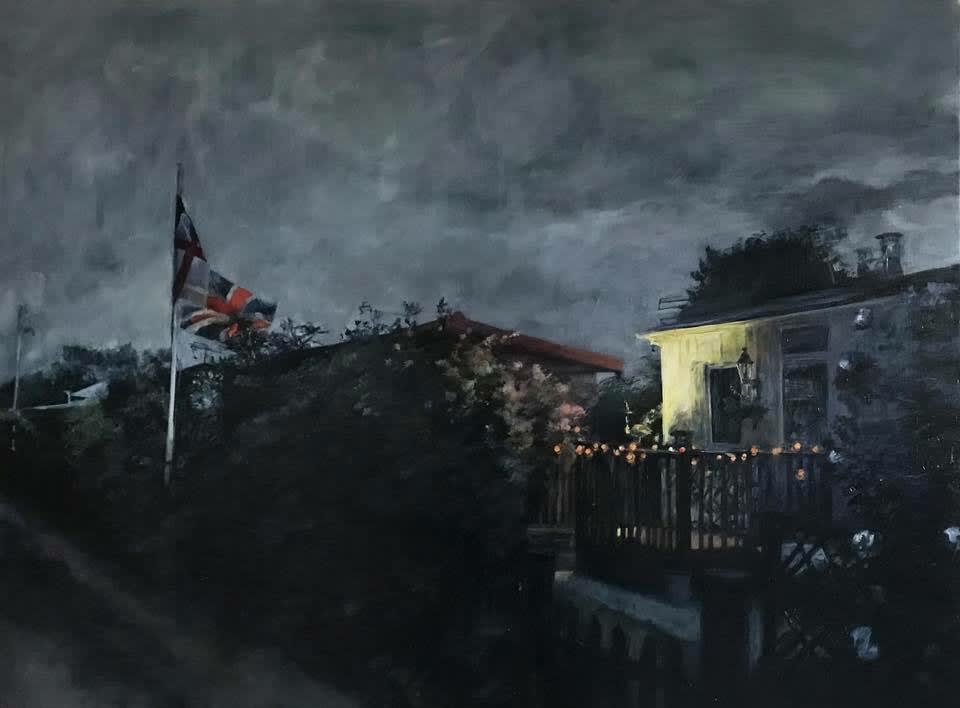
‘Why Destroy a Thing of Beauty?’ 60 cm x 80 cm, oil on linen, 2019
Awarded the “Scenes of Everyday Life” category prize in the prestigious Jackson’s Painting Prize 2020, ‘Why Destroy a Thing of Beauty?’ by Judith Tucker was one of six category winners out of 5634 artworks submitted internationally.
Earlier this year, in April, right in the middle of lockdown and during her recovery from COVID19, artist Judith Tucker had some good news. After being shortlisted for the prestigious Jackson Painting Prize for the last three consecutive years, her painting, ‘Why Destroy a Thing of Beauty?’ had been selected as the prize-winning painting for the ‘Scenes of Everyday Life’ category prize. It was a very uplifting and proud moment for the artist and we were absolutely delighted for her.
Cavaliero Finn has shown Judith’s paintings for around ten years both at art fairs and in the home gallery in London. While her expertly painted landscapes depict a visual representation of a geographical place, they always have a deeper tale to tell, for Judith is very much drawn to landscapes which have strong visible histories and her response to them often borders on obsession. A Senior Lecturer at Leeds University, Judith’s approach to her subject matter is researched-based as she talks to residents and studies historical articles about her chosen location. Alongside her painting, she works in collaboration with other artists such as the poet Harriet Tarlo, all the time collecting information to enrich her perspective and gain a deeper understanding of a particular landscape and the relationship its inhabitants have to it. It is through this process that Judith is able to completely capture the essence of the landscape in which she works through her painting, This is most apparent in her recent body of work which focusses on an area on the North East Lincolnshire coast where a coastal community live on one of the UK’s last existing plotlands, the Humberston Fitties. It is a place that has fascinated Judith since 2013 and was the subject matter of Judith’s Jackson Prize-winning painting. In this work as well as painting what appears to be a fond tribute to the rather eccentric community of chalet dwellers, she also gives an insight into a particular political and localised demographic. In her Night Fitties Series, the paintings explore the play of light and dark and the uncanny transformations of the chalets that take place after hours as well as notions of vulnerability, occupation and emptiness. The work considers, in the shadow of recent dramatic political changes, how notions of place and identity are constructed on domestic and larger scales, as reflected by the inclusions of flags and other indications of “Englishness” in her
We chatted to Judith earlier this week about this particular body of work, about her career as an artist and academic and her latest body of work The Dark Marsh Series.

Judith in her studio which is at the top of her home in West Yorkshire Cavaliero Finn: How did you become an artist Judith?
Judith Tucker: I can’t remember a time when I wasn’t drawing or painting. My mother was a novelist and my sisters, and I grew up in a pretty bohemian environment where creativity was valued. So being an artist was not really any kind of rebellion and when I was eighteen, I went to the Ruskin School of Art in Oxford. I was one of the first cohort of students that was part of the University, I met two of my closest painting friends there: Gavin Maughfling and Pandora Mond. Years later I still talk with them regularly about our work. I moved back to London after that and shared a studio in Metropolitan Wharf, Wapping for some years and then had my studio at home, I still do now.
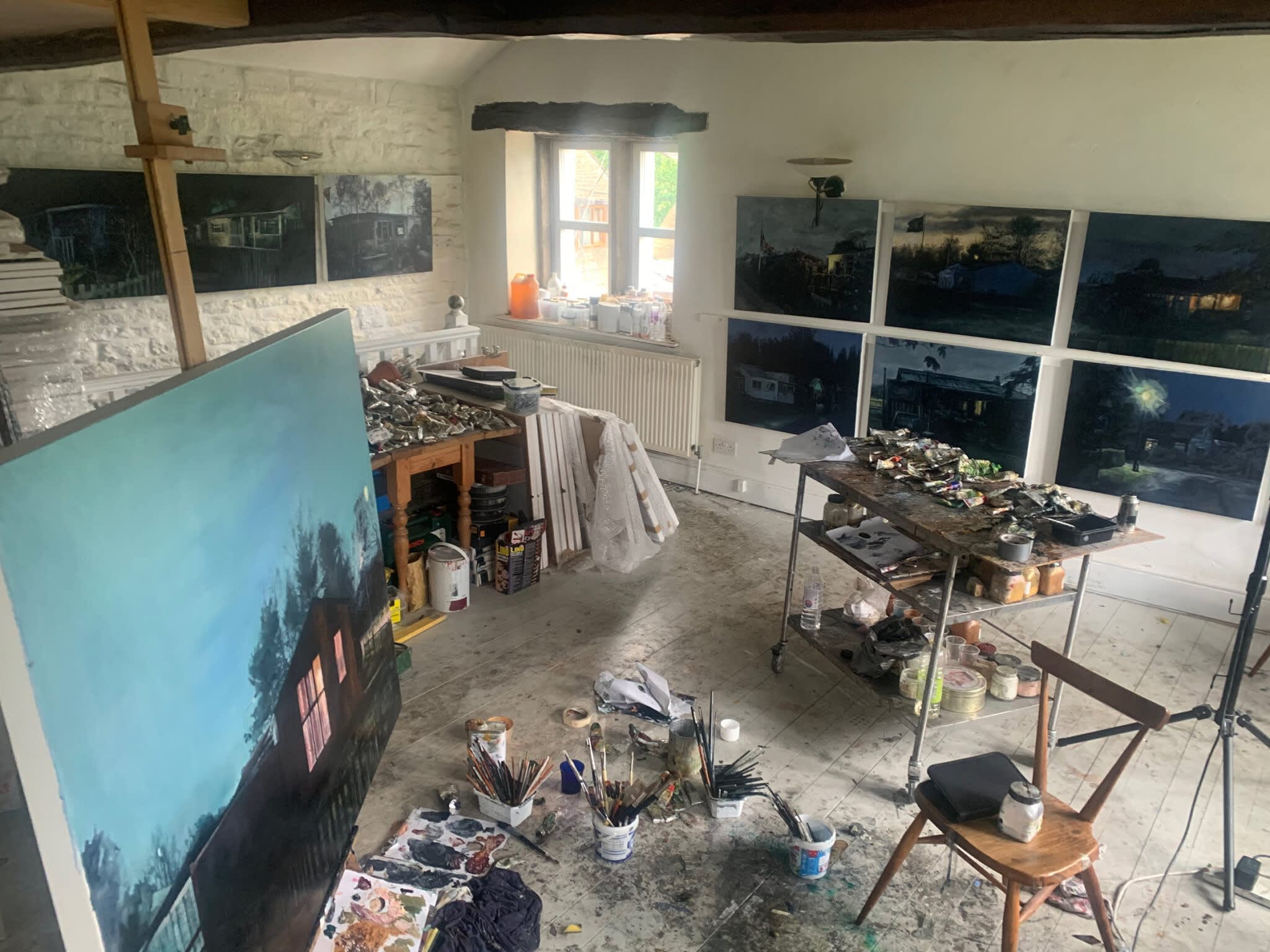
Work in progress in Judith’s studio
Judith Tucker: My studio is at the top of a farmhouse in West Yorkshire. One of the aspects of this space that is so appealing is that it was always a workshop or store area for wool or weaving: it was never part of the living area, right from when it was built. When I’m painting in there, I like to think about all those who worked in it before me. I used those early years to consolidate and build up my practice and to try to understand what it was that painting could do and perhaps more importantly what I could do with painting. My various studios were the places I went to ground myself; painting was just what I did, what I had to do, to figure out the world and what was going on. I used to go on field trips and make lots of sketchbooks and other material from the British coast and then work those up in the studio. I showed a little at that time and was shortlisted for the Windsor and Newton young artists award and the Bayer Earth Art prize.
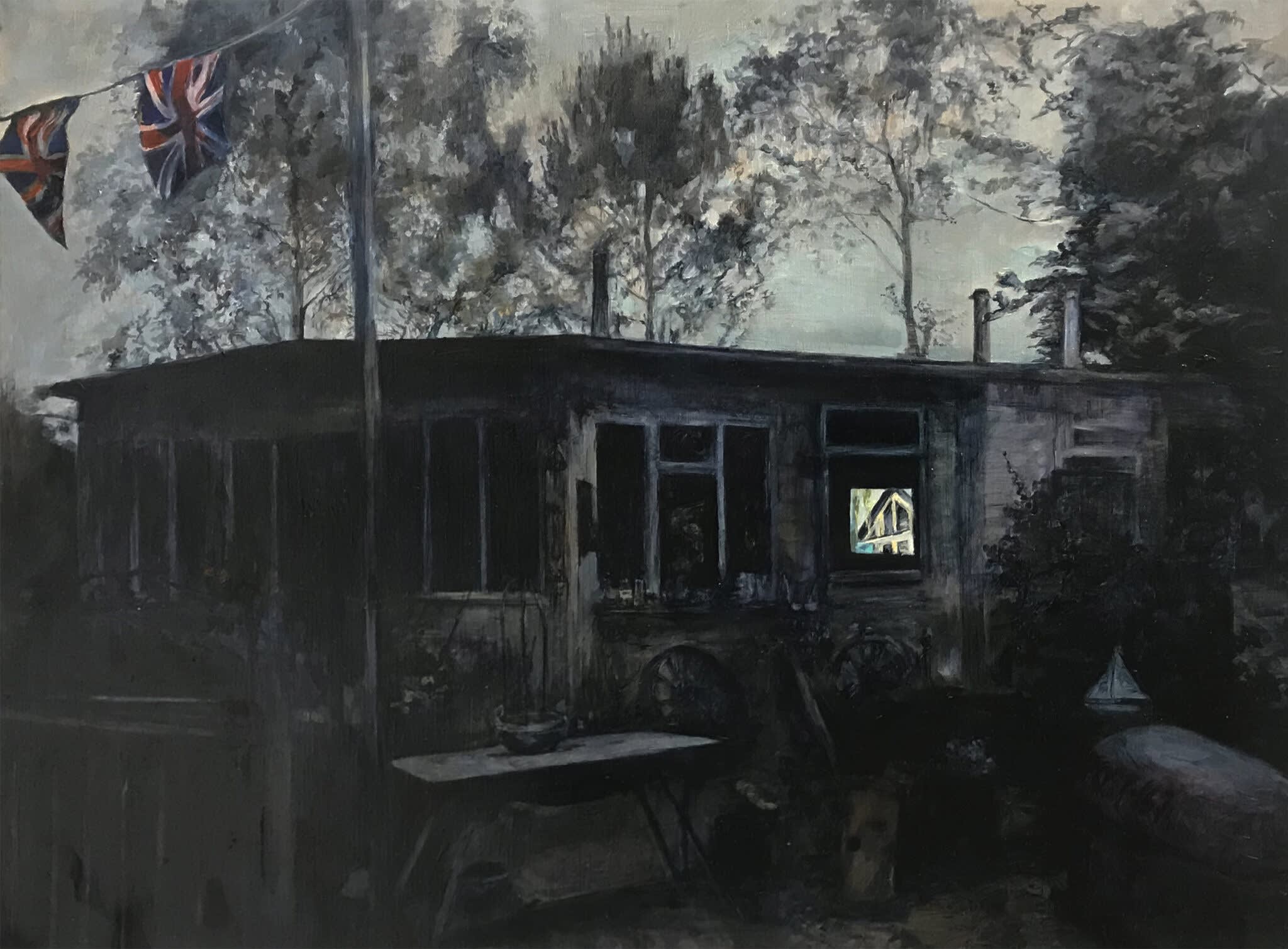
Judith Tucker: They’d Have A Party And Everyone Could Go, oil on linen, 60cm x 80cm 2019 Cavaliero Finn: You were born in Wales; how long did you live there, and have you ever taken inspiration from the Welsh landscape or Welsh literature in your work?
Judith Tucker: I lived on Anglesey in Beaumaris until I was six as my father worked at the University of Bangor at that time. When we moved to London, I remember thinking that it was a very dark place and that all the houses and buildings were crammed very close together. I really missed the sea and the view from where we lived across the Menai Straits to the mountains of Snowdonia. I missed playing on the beach, the sound of the seagulls and the atmosphere of a seaside town both in and out of season. So, although I have never directly made work from the Welsh landscape, I do think that this childhood longing must have been influential in my later, deep interest in holiday resorts, from Ahlbeck and Friedrichroda in Germany, the Island of Bornholm and in my most recent work at the Humberston Fitties.
Judith Tucker: You Knew Where You Were and How Long You Had It, oil on canvas, 76 x 101 cm, 2019
Cavaliero Finn: This year you won the “Scenes of Everyday Life” category prize in the prestigious Jackson’s Painting Prize 2020 for your painting ‘Why Destroy a Thing of Beauty? [shown at the beginning of this feature]. What did winning this prize mean to you?
Judith Tucker: I was really delighted and very proud of course, as although I’ve made it to the shortlist and been exhibited in some competition shows over the years, this was the first time I had been awarded a prize. It was third time lucky for me in this particular one as I was shortlisted for the Jackson’s Painting Prize in 2018 and 2019. I relish that it’s a painting prize and has nothing to do with academia. Moments like this do not change your life, as I might have thought when I was younger, but they do make me feel that, having painted for so many years, at long last I might be getting somewhere with it. For me, painting is a very slow burn indeed, in the past people would really admire my drawings and be quieter about my paintings, this is no longer the case.
Judith Tucker: It Was All Dunes Around Here, oil on canvas, 61 x 182 cm, 2019
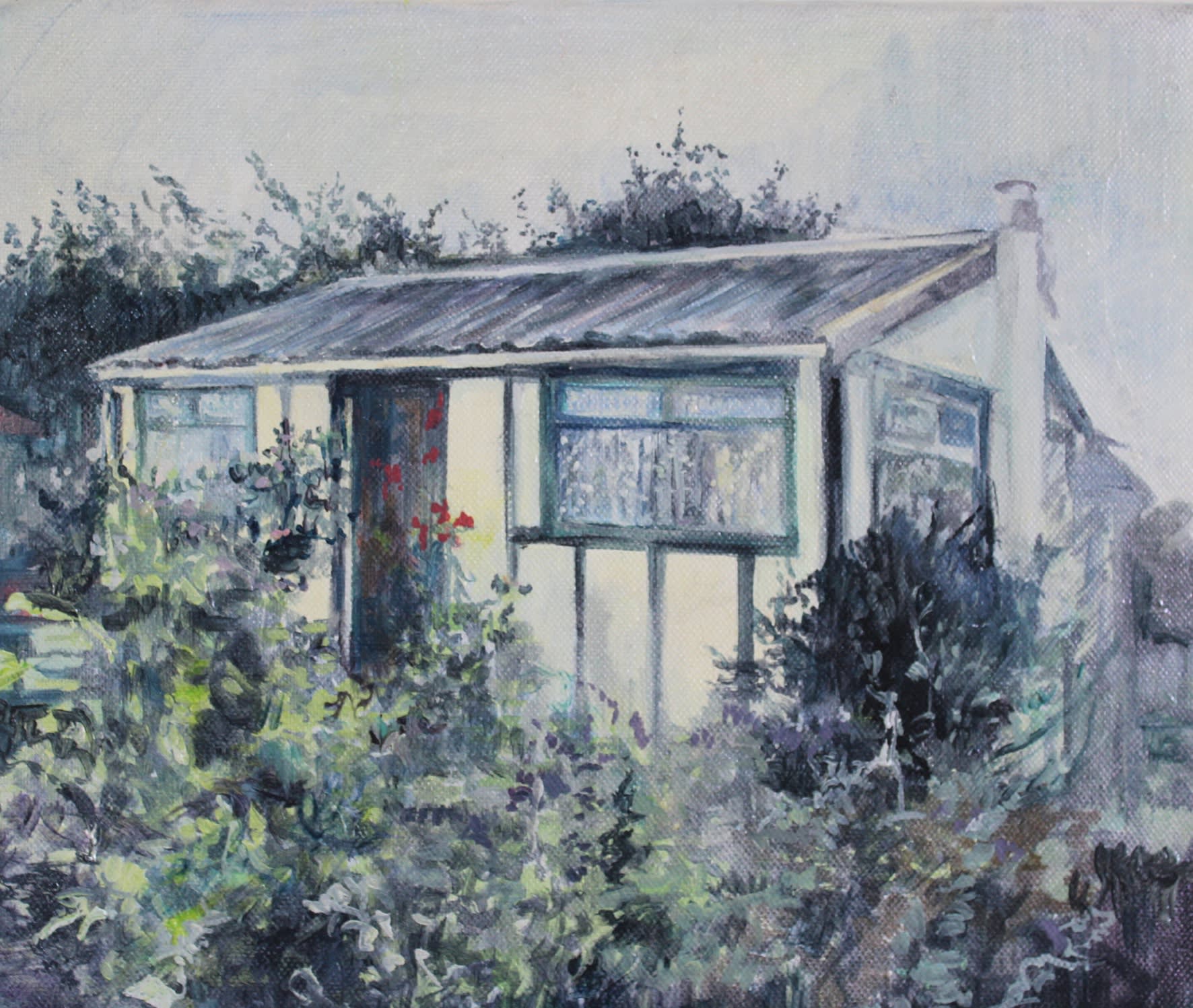
Judith Tucker: Chalet Era, 25.5cm x 30.5cm, oil on canvas, 2019
Cavaliero Finn: Your winning prize entry to the Jackon Painting Prize was a painting from your Night Fitties Series. How did you first come across the Humberston Fitties and what initially drew you to make this series of paintings?
Judith Tucker: The Humberston Fitties plotland or Chalet Park has been around since between the two World Wars but which we first discovered it in 2013 when doing some work on the beautiful North Lincolnshire coast, thanks to an Arts Council England commission via the curator and artist Linda Ingham. At first, the Fitties was just a part of a larger project and the chalets somewhere fun and quirky to stay when doing fieldwork, but gradually we became drawn to the individualistic properties and people, the stories and histories behind the chalets and the whole plotland movement. The word Fitties itself is an old word for saltmarsh and the work I make there is always in conversation with the landscape paintings of the surrounding marshland from which the Fitties was sculpted. The marsh, beach and natural environment are intrinsic to what has drawn people to the area.
Judith Tucker: And We’d Walk Down Here To The Beach, oil on linen, 60 x 80cm, 2019
Cavaliero Finn: This series is a collaboration with the landscape poet Harriet Tarlo, how do you work together and how do you unite the written word with the visual?
Judith Tucker: Harriet and I started working together in 2011. Our work emerges from walking together, making work in the landscape and then developing drawings, paintings, and poetry in conversation. We enjoy exploring our different disciplines and this challenges us to push the work further and consider the limitations as well as the possibilities of our different art forms in relation to landscape. We are both interested in environmentalism also and this feeds into our work. Exploring the Fitties through observation but also interviews helps us understand how people relate to place and even the potential for a different way of living in the world.
When we present the work in exhibitions and artists’ books, we do not merge text and image but allow for space and separation between word and image, inviting the viewer in to make connections and join the conversation. This allows for unexpected aspects of our collaboration to emerge so for example silent, static paintings and drawings might become filled with the sound and movement of voices and language. There is something not a little obsessional about artists and writers – it is both powerful and fun to share these obsessions with particular places with another person.
The titles of the Night Fitties series all come from Harriet’s poems, these particular poems are all made from found phrases from our interviews with chalet owners and holidaymakers. It’s a way of bringing those voices into my work, the paintings have hints of the inhabitants but never picture them.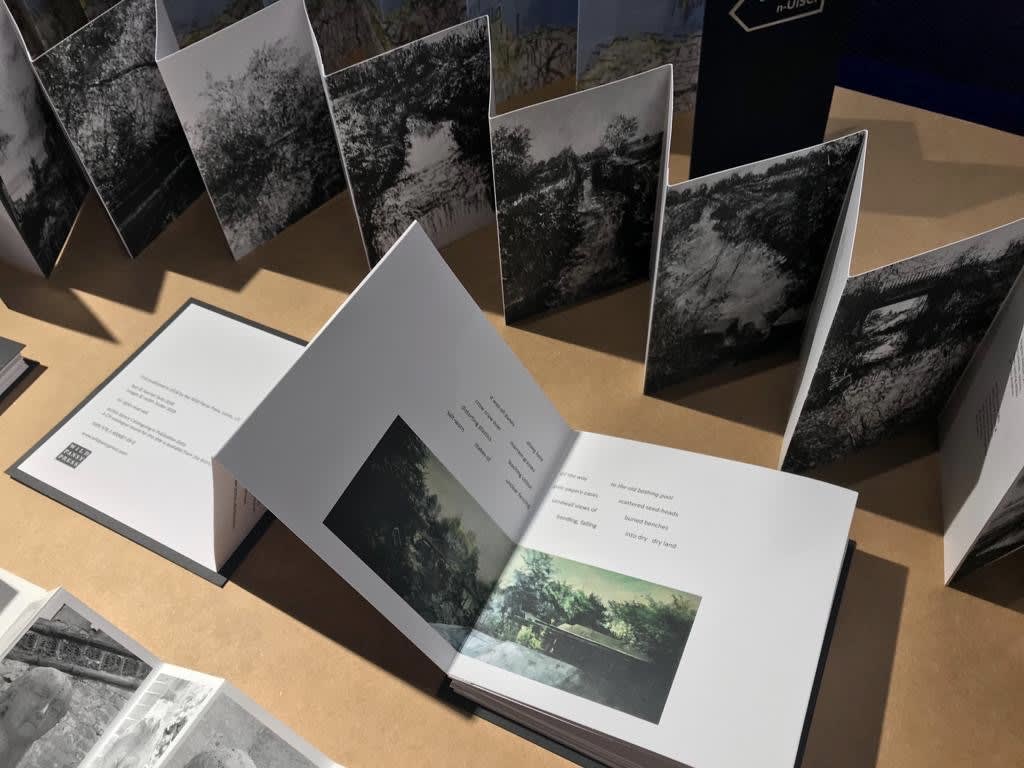
behind land: poems and paintings, Harriet Tarlo and Judith Tucker, Wild Pansy Press
outfalls: poems and drawings, Harriet Tarlo and Judith Tucker, Wild Pansy Press Cavaliero Finn: There’s a wonderfully sinister undertone to some of these paintings. Was that intentional and are you interested in presenting another story or are you more interested in representing the community as you see it?
Judith Tucker: It is through the materials and processes of art, not just the ostensible subject matter, that we subvert the ordinary. Painting in particular, with its many layers and glazes, oscillates between the thing itself, its own materiality, and acting as a surface sign or image. There is a relationship for me between these processes of layering and meshing the viscosity and liquidity of the paint with the salt marsh itself and, by extension, the Fitties. The layering inherent in digital imagery reflects, informs and contrasts with those in painting. Like most painters, I photograph as well as draw in the places I work, as well as looking at older images and hearing stories about the place, so my paintings are haunted by all those layers material and metaphysical. This contributes to the feelings that are evoked, be they sinister or joyful, feelings I hope not to dictate in my work, but merely to suggest. Recent events which have revealed how divided and fragile our society is, such as Brexit, and now the Covid-19 crisis, feed into this work as do more local debates about the future of this Plotland that have been exacerbated in recent years. You can see this in particular in the play of flags and Englishness in some of the works. My first audience is very often the chalet owners as there is a Facebook page related to the series and I post finished works there, and it’s always a relief when they approve – and thank goodness they do, even of the most eerie works.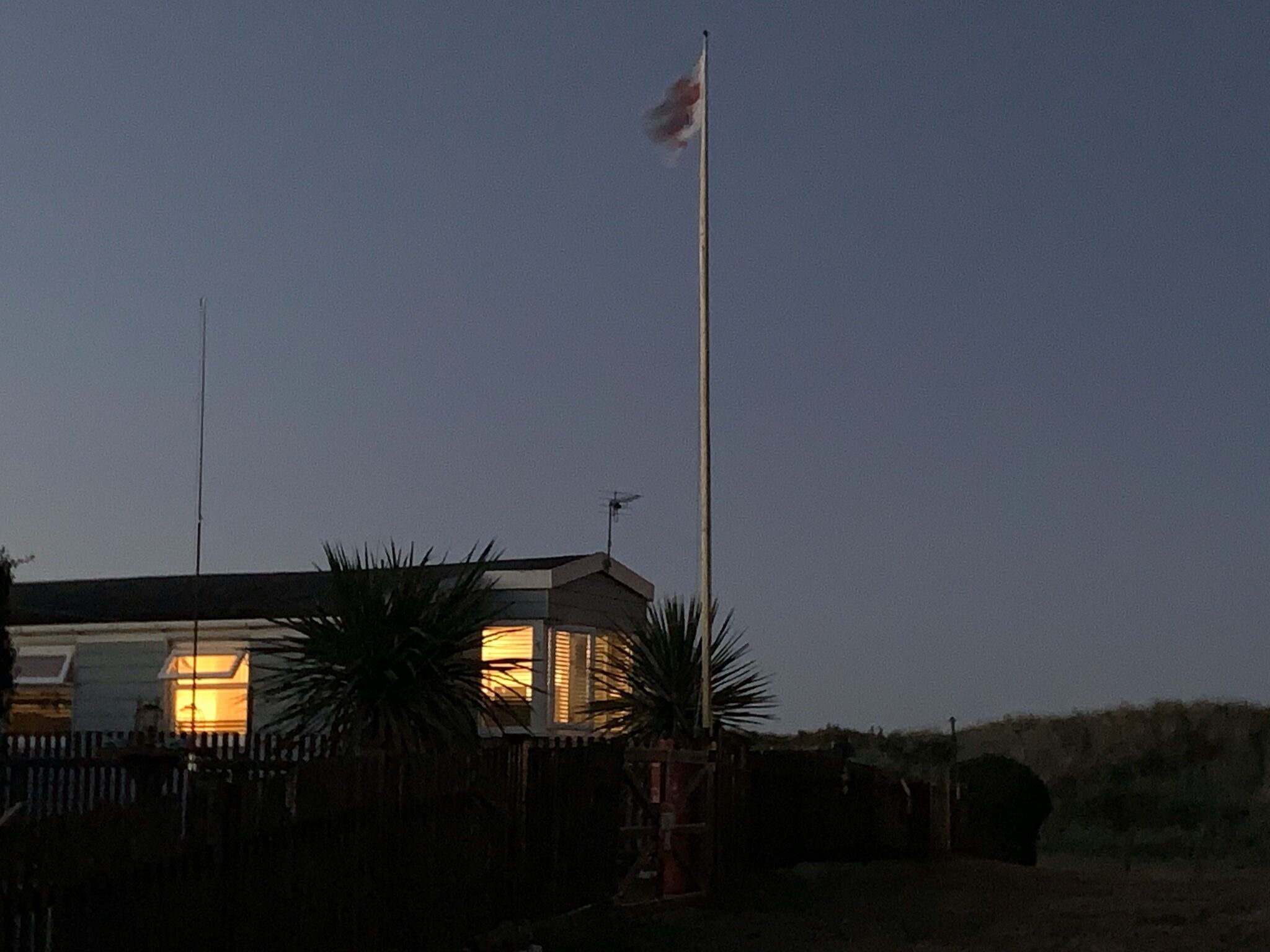

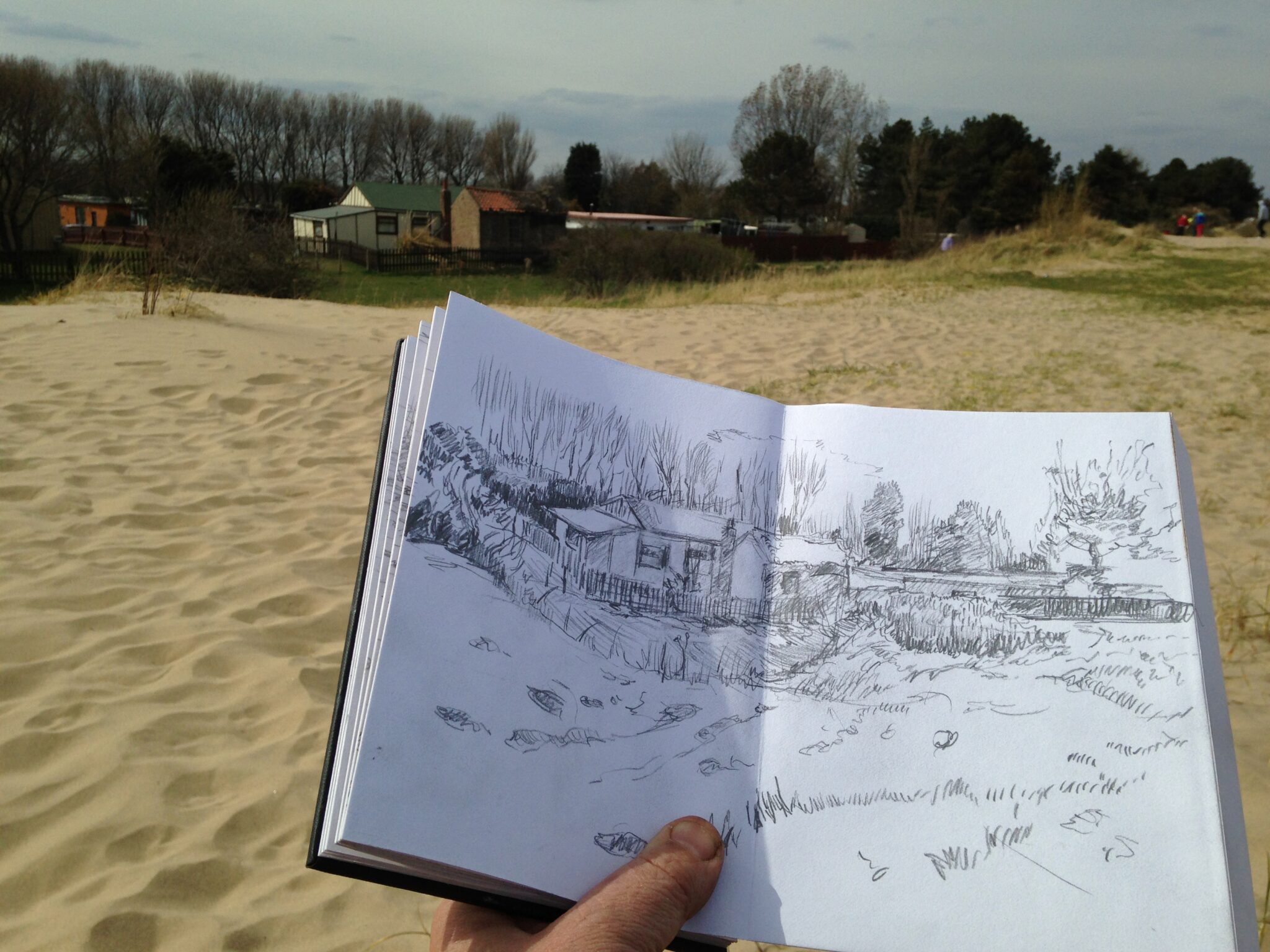
Cavaliero Finn: How do you start your paintings, and do you work on each one individually or several at a time? There’s such a beautiful dialogue between the work and the light is quite phenomenal in all of them.
Judith Tucker: I have all my source material around me in the studio: photographs, drawings and Harriet’s poems and notes from the interviews. First, I block in the composition in monochrome, usually in Payne’s Grey. Then I build up my paintings in layers using a variation on the traditional chiaroscuro technique, and in a way exploring different kinds of light is as important and is as much the subject matter of my work as the inanimate objects represented. I do work on several paintings at the same time, all at different stages of development. This helps build up the sense of a series, I paint surrounded by them all and I find that helpful as I can then see how the work is developing and work out how to develop the next one. In my recent Night Fitties series I became especially interested in the contrasts, shadows and defamiliarization of the plotland at night. Our fieldwork took on a different quality as we walked around the site after dark, photographing, writing and talking about what we were seeing on those familiar roads and tracks.
Judith Tucker: It Really Did Used To Be Like This, oil on linen, 60 x 80cm, 2019
Cavaliero Finn: Are there any artists that inspire your work? The sense of wildness and abandonment is often present, is this something you seek out?
Judith Tucker: There are so many fantastic current painters who work with and against the genre of landscape painting in a fresh contemporary way, I really admire Hannah Brown, Graham Crowley, Joanna Whittle, Julian Perry, Juliette Losq and then, of course, there’s Kate Sherman who shows with you, her coastal series is really evocative.
I have always been interested in abandoned places, yes, but I am also interested in inhabited places as this current work shows. My sense of exploring the tension between wild and domestic, natural and cultural, human and more-than-human has been informed by developments in the environmental arts and humanities which help us understand that such binaries don’t really exist at all. We are always in a complex mesh of betwixt and between. Painting, I feel, is capable of exploring these complexities in visceral form.
Winner of the Contemporary British Painting Prize 2019, Joanna Whittle: Winter, 2019, oil on canvas
18 x 24 cm (Private Collection). Image courtesy of Joanna Whittle.
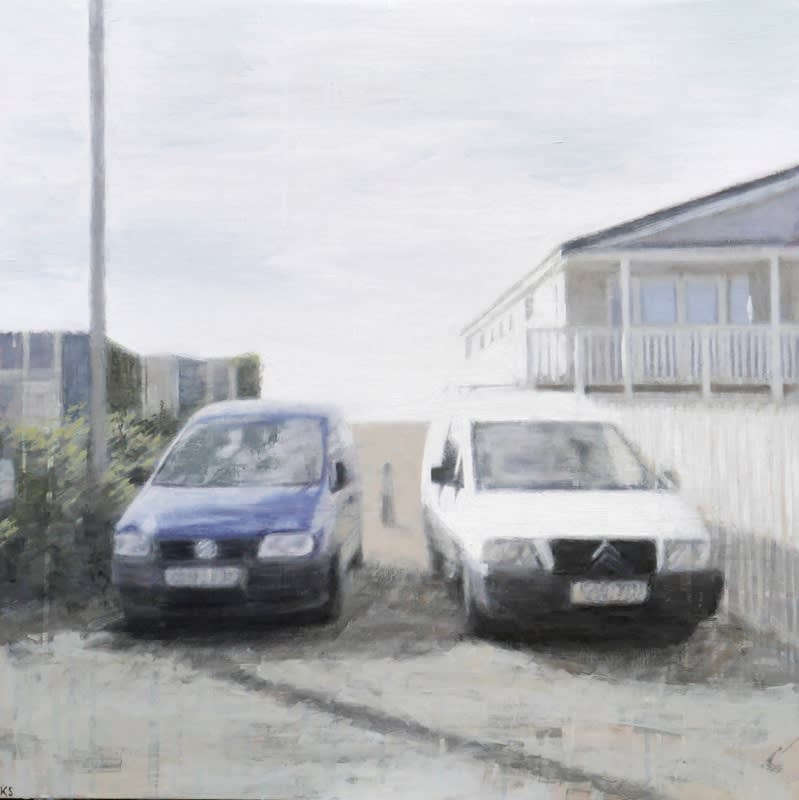
Kate Sherman – Coast 11. Oil on board (60 x 60 cm) 2019
Cavaliero Finn: What is your favourite work of art?
Judith Tucker: An impossible question, but here’s two out of many that make for an unlikely combination – Dürer’s Great Piece of Turf and George Shaw Almost Lost 2008 which you can see in Southampton City Art Gallery.
Cavaliero Finn: We are seeing glimpses of your new series Dark Marsh. How did this evolve from the Fitties series?
Judith Tucker: Dark Marsh considers the pioneering salt marsh plants of the Humberston Fitties, on the borders of Tetney Marsh so, at one level, the relationship is simply geographical. We were drawn to these plants visually, but also in terms of their ecological niche. They are both vulnerable to sea-level rise, but also help to protect the land from flooding, so raise many questions about saltmarsh and coastal erosion. The work is indeed intended to be seen in relation to the Night Fitties. Together the two series explore human and more-than-human worlds in microcosm and juxtaposition, touching on the play of light, tide and colour, uncanny transformations after dark, and notions of vulnerability, occupation, resilience and reclamation. Harriet Tarlo and I plan to extend this work in the coming years, hoping to deepen further our understanding and to make new exhibitions and publications related to it.
Judith Tucker: Dark Marsh: Winter Samphire, oil on linen 30 x 40 cm 2020
Currently on show in the Harley OpenCavaliero Finn: You are a senior lecturer at the University of Leeds, tell us a bit about this and how your academic work feeds into your paintings?
Judith Tucker: In the late nineties I moved to Yorkshire, first doing an M.A. in Fine Art where I met Rowena Brown whose wonderful ceramics you also show, followed by a PhD in Fine Art at the University of Leeds. Much to my surprise, I thrived on the way that theory and practice can intertwine. Although, of course, I don’t think to do a PhD necessarily makes one a great artist, however, for me, having time to both make, read and think, and then to think through making was so valuable. What was a real career changer though, was getting a three-year Arts and Humanities Research Council (AHRC) fellowship in the Creative and Performing Arts also at the University of Leeds, after which I gained a permanent position where I enjoy working with my students and colleagues. I choose not to be full-time at the university to allow time to work in my studio.
The scholars that influence my work are those who privilege the affective role of the creative arts in their writing. These include Griselda Pollock on trauma in relation to painting; Marianne Hirsch on second-generation memory; Karen Till on spectral traces, Iain Biggs for his development of ideas of deep mapping, Kate Soper’s writings questioning our assumptions about nature, and David Matless’ considerations of the anthroposcenic to name just a few. Through Leeds, I co-convene the creative practice-led research network LAND2, a network of artist/academics and research students interested in landscape/place-oriented art practice. We run symposia, conferences, exhibitions and field trips which stimulate and provoke me to ask further questions about my work. More recently being a part of the artist-led group Contemporary British Painting has also been key for me in terms of conversation and debate about painting.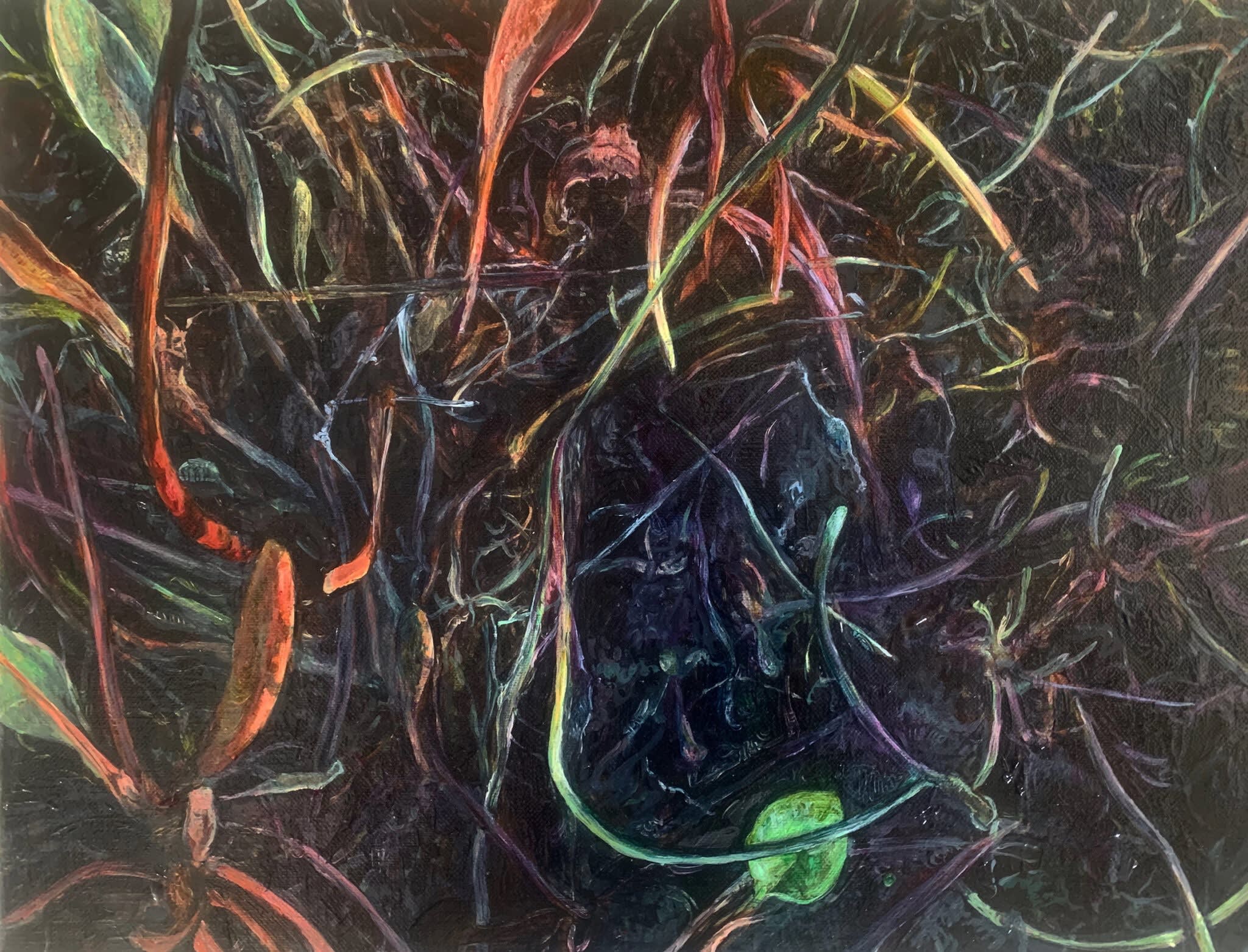
Judith Tucker: Dark Marsh: Winter Tangle, oil on linen, 30 x 40 cm 2020
Currently on show in the Harley OpenSee more work by Judith Tucker here